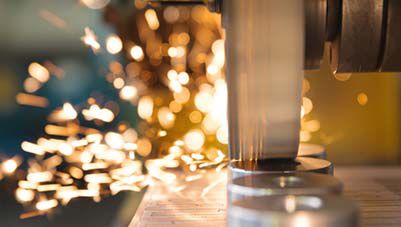Laser cutting has become the preferred solution for manufacturers seeking precise, consistent, and clean cuts without the hassle of frequent tool maintenance. Whether working with metal, wood, acrylic, or composite materials, this technology delivers a level of accuracy that traditional cutting methods struggle to achieve. Companies that rely on customised parts, rapid prototyping, or high-volume production often consider laser cutters essential rather than optional. If you are planning to expand operations or integrate automated processes, assessing your business loan eligibility early can help determine how quickly you can invest in the right equipment for your production needs.
What is a laser cutting machine?
A laser cutting machine is a sophisticated fabrication tool that uses a highly focused, high-energy laser beam to accurately cut or engrave a wide range of materials for industrial or creative purposes. The machine directs intense light onto the material’s surface, instantly melting, burning, or vaporising it to create intricate, precise cuts or designs. It is always advisable to check your business loan eligibility before investing in a high-performance laser cutting machine.
| Full bleed banner Component | |||
| Topic | Mandatory/ Optional | Char Limit | Content to update on page |
| Background image 1 | Mandatory | NA | Images/BOL/bl-2 |
| Background Image Alt Text | Mandatory | 10 Char | Business Loan |
| Banner URL | Mandatory | NA | https://www.bajajfinserv.in/business-loan?sso-module=adp |
| Section wrapper Required | Mandatory | NA | yes |
| Sequence order | Mandatory | 10 Char | 1 |
| Topic | Mandatory/ Optional | Char Limit | Content to update on page |
| Background image 2 | Mandatory | NA | Images/BOL/BL3 (1) |
| Background Image Alt Text | Mandatory | 10 Char | Business Loan |
| Banner URL | Mandatory | NA | https://www.bajajfinserv.in/personal-loan-for-self-employed?sso-module=adp |
| Section wrapper Required | Mandatory | NA | yes |
| Sequence order | Mandatory | 10 Char | 2 |
How does a laser cutting machine work?
Laser cutting machines deliver clean, precise cuts by combining advanced optics, computer numerical control (CNC) motion, and assist gases. The key process works as follows:
- The laser source produces a beam, which is precisely focused to an intense fine point using mirrors and specialised lenses within the machine.
- The concentrated beam heats the material locally, instantly melting or vapourising it as the laser head follows the programmed path.
- Assist gases, such as oxygen or nitrogen, are directed through the nozzle to remove molten material, prevent combustion, and maintain the clean edge quality of the cut.
- CNC systems accurately control the movement of the laser head or the material bed, ensuring high-precision, high-tolerance cuts.
Different types of laser cutting machine
Laser cutting machines are classified according to their laser source, with each type tailored to specific materials and applications:
- CO₂ laser cutting machines: The most common type, ideal for non-metallic materials such as wood, acrylic, and leather, as well as some thin metals.
- Fibre laser cutting machines: Highly efficient for cutting reflective metals like stainless steel, aluminium, and copper, providing faster processing speeds.
- Nd:YAG laser cutting machines: Suited for highly precise, delicate cutting, drilling, or intricate engraving tasks.
Components of a laser cutting machine
A fully operational Laser Cutting Machine combines several sophisticated systems:
- Laser source: The primary power unit (e.g., CO₂, Fibre, Nd:YAG) that determines the type of machine.
- Beam delivery system: Mirrors, optics, and lenses that focus and direct the laser beam.
- CNC motion system: Precisely controls the movement of the cutting head.
- Assist gas system: Provides gas to protect the optics and remove molten material from the cut.
- Safety enclosures and filtration: Crucial for safe operation and for managing fumes generated during cutting.
What are the main laser cutting machine parameters?
To achieve optimal performance from a Laser Cutting Machine, it is important to adjust the following key parameters:
- Laser power: The main setting that determines cut thickness and speed.
- Cutting speed: Affects precision, edge quality, and the heat-affected zone (HAZ).
- Focus position: Vital for producing a narrow kerf and clean, sharp edges.
- Assist gas and pressure: Helps remove molten material and enhances cutting efficiency.
- Pulse settings: Important for pulsed Laser Cutting Machines when piercing materials or cutting fine details.
Advantages of laser cutting machine
The operational advantages of using a Laser Cutting Machine are considerable:
- High precision: Delivers exceptional accuracy and tight tolerances for intricate designs.
- Versatile material capability: Can cut metals, plastics, wood, textiles, and composite materials.
- Speed and efficiency: Fast and highly efficient, particularly for repetitive tasks or complex geometries.
- Minimal tool wear: As a non-contact process, it eliminates costs and downtime associated with replacing physical tooling.
- Low finishing requirements: Produces clean edges, often needing little or no post-processing.
Disadvantages of laser cutting machine
Despite its advanced capabilities, the laser cutting machine has some limitations:
- Material thickness: Efficiency decreases when cutting materials thicker than typical industrial standards (e.g., 12–25 mm).
- High initial cost: Involves a substantial investment in both the machine and its safety infrastructure.
- Energy consumption: Laser cutting machines can require significant power during operation.
- Fume management: Cutting generates potentially harmful fumes, making effective extraction and filtration systems essential.
- Operator expertise: Skilled personnel are needed to programme and operate the machine for optimal performance.
Difference between laser cutting machine and water jet cutting
| Aspect | Laser cutting | Water jet cutting |
|---|---|---|
| Thickness capability | Good for medium to thin materials | Cuts very thick materials effectively |
| Edge finish | Clean, narrow kerf, minimal heat-affected zone | No heat‑affected zone, slightly wider kerf |
| Tooling needs | No physical tooling required | May require abrasives and specific nozzles |
| Material limitations | Issues with reflective or heat-sensitive materials | Handles most materials, including reflective/heat-sensitive ones |
| Speed and automation | High speed, easily automated | Slower, especially on thick materials |
Buying guide for laser cutting machine
When choosing a new laser cutting machine, consider your future operational requirements:
- Material and thickness: Identify the range of materials and maximum thickness you will regularly cut.
- Laser type: Select the appropriate laser source (Fibre, CO₂, Nd:YAG) based on your primary materials (e.g., Fibre for metals).
- Power and productivity: Choose a power level that meets your desired cutting speed and throughput.
- Bed size and automation: Ensure the bed accommodates your standard sheet sizes and can support any planned automation, such as automated loading or unloading.
- Support and maintenance: Assess the long-term costs and availability of after-sales service for the machine.
To simplify acquisition, consider machinery loan finance options designed for high-value equipment like a laser cutting machine.
Price range of laser cutting machines in India
The table below shows approximate price ranges (in Indian Rupees, INR) for various types of new laser cutting machines in India. Prices may vary depending on the brand, power, and supplier.
| Laser cutter type | Price range (INR) |
|---|---|
| Diode laser cutter (desktop/hobby) | Rs. 75,000 – Rs. 2,00,000 |
| CO₂ laser cutter (non-metal, entry/mid-level) | Rs. 1 lakh – Rs. 5.5 lakh |
| CO₂ laser cutter (non-metal, industrial) | Rs. 5 lakh – Rs. 12 lakh+ |
| Fibre laser cutter (metal, entry/mid-level) | Rs. 15 lakh – Rs. 40 lakh |
| Fibre laser cutter (metal, high-power industrial) | Rs. 40 lakh – Rs. 1 crore+ |
| 3D & robotic laser systems | Rs. 50 lakh – Rs. 5 crore+ |
Laser cutting machine financing options
Given the high cost of a professional laser cutting machine, several financing options can help ease the financial burden:
- Term loans: Traditional loans with fixed interest rates and repayment schedules.
- Equipment leasing: Enables you to use the laser cutting machine with the option to purchase it later.
- Line-of-credit solutions: Offers flexible access to working capital required to integrate the new machine.
- Custom EMI plans: Tailored repayment schedules aligned with your business’s revenue cycle.
For effective financial support, industrial equipment finance is a reliable way to secure a new laser cutting machine.
Conclusion
Laser cutting machines offer high precision, versatility, and efficiency across a wide range of industries. While they require significant upfront and operational investment, their advantages make them worthwhile for tasks that demand clean, intricate cuts. For manufacturers looking to expand or enhance their capabilities, securing a business loan can help fund this strategic investment. It is advisable to check your business loan eligibility beforehand to ensure you meet the necessary criteria. Using a business loan eligibility calculator can provide an instant estimate of the amount you may qualify for. Additionally, comparing business loan interest rates from different lenders is an important step in finding a financing option that fits your budget and helps manage the overall cost of your investment.












